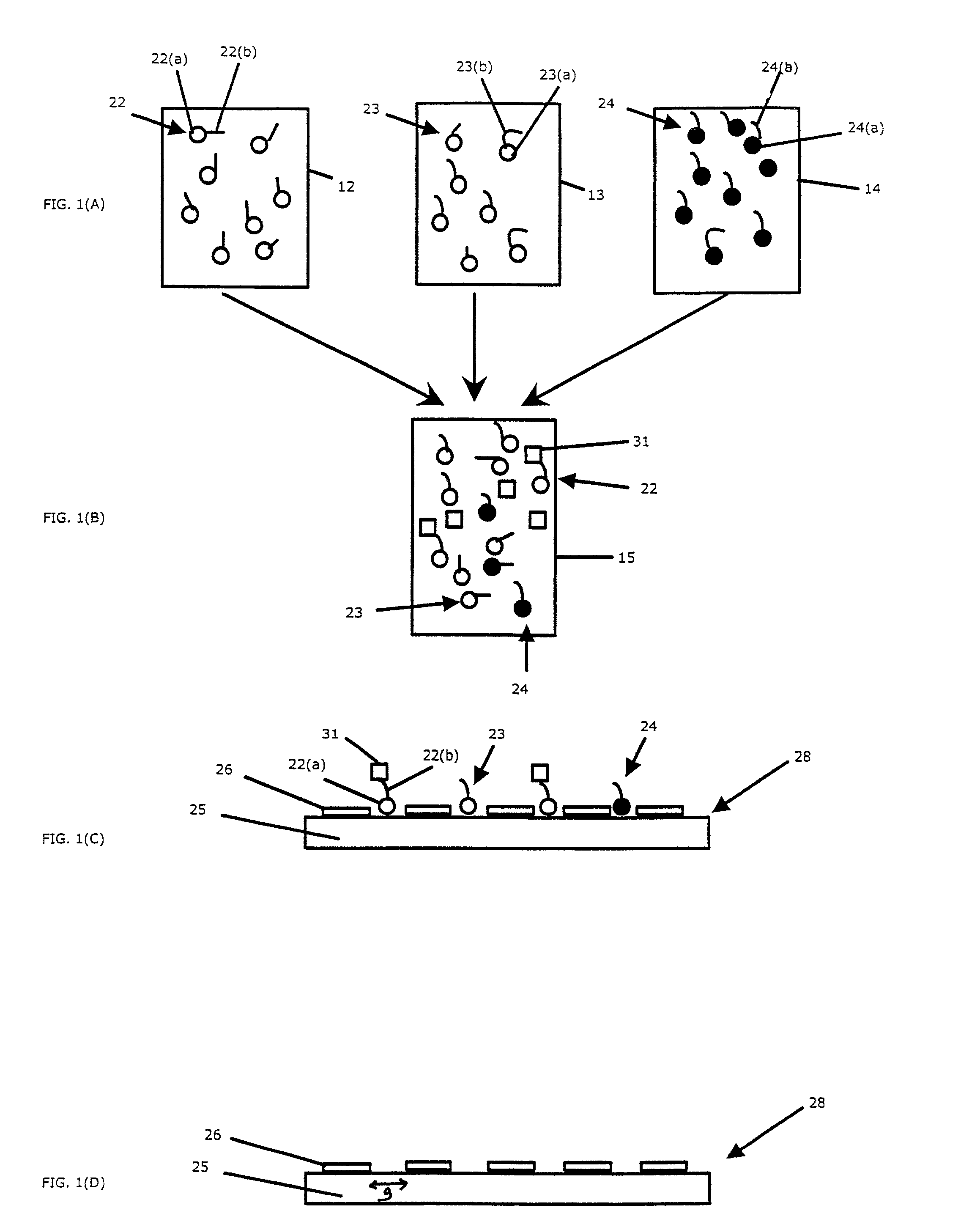Devices and methods to form a randomly ordered array of magnetic beads and uses thereof
a randomly ordered array and magnetic particle technology, applied in the field of randomly ordered arrays of magnetic particles, can solve the problems of difficult adaptability or reuse of arrays, high labor intensity and time consumption, and subject to variability
- Summary
- Abstract
- Description
- Claims
- Application Information
AI Technical Summary
Benefits of technology
Problems solved by technology
Method used
Image
Examples
example 1
Fabricating Magnetic Chips
[0165](1) Cobalt film approximately 700-1000 nm thick was deposited on a silicon wafer with a diameter of approximately 3.0 inches. The cobalt layers were sputtered sequentially without breaking vacuum using a UHV DC magnetron sputtering system at 2×10−8 torr. The deposition rate was 0.39 nm / sec. An e-beam lithographic pattern was written using a Hitachi HL-700F instrument, a direct write patterning tool with a minimum feature size of 50 nm, and a UVN30 photoresist at 5.5 Krpm spin for 40 sec. The resulting photoresist layer was approximately 500 nm thick. The photoresist was then developed with MF-CD 26 for 30 sec. The chip configuration defined by the mask resulted in a pattern of diamond-shaped magnetic regions.
[0166]To fabricate the magnetic islands, argon sputter etching was performed in an ion-milling etcher without breaking vacuum and with the photoresist as the mask. Time intervals of 10 min etching / 10 min cooling were used for a total of 80 min. Th...
example 2
Assembling a Random Array of Magnetic Beads on a Magnetic Chip
[0168]A magnetic chip was fabricated essentially as described in Example 1 except that (i) the mask was designed to produce a chip with a 10×10 array of arrays, with each subarray having a 30×30 configuration of magnetic islands; (ii) the magnetic islands were diamond-shaped rather than rectangular and had an island-to-island spacing of approximately 20 μm in both the x- and y-dimensions, and (ii) the etching time was varied across the chip in the x-dimension, resulting in a gap of variable width, ranging between 1 and 4 μm.
[0169]A stock solution of superparamagnetic beads (streptavidin-conjugated M-280 Dynabeads obtained from Dynal Biotech, Inc.) was washed with buffer according to the directions of the manufacturer and labeled with biotinylated fluorescent R-phycoerythrin dye (Molecular Probes, Inc.) also according to the directions of the manufacturer. The beads were diluted at 40:1 in 1×TE (Tris-EDTA) with 0.1% SDS, y...
example 3
Detecting DNA Hybridization Using a Random Array of Magnetic Beads
[0172]A stock solution of superparamagnetic streptavidin-conjugated M-280 Dynal beads (10 mg / ml) was cleaned thrice following the manufacturer's directions. The stock beads are specified to bind up to 20 pmole of biotinylated oligo per 10 ul of stock beads. We cleaned 10 ul of stock beads and diluted them 2-fold to 20 ul. 200 pm of biotinylated oligo (2 ul of 100 pm / ul) was then added and bound to the bead for 30 minutes at 40° C. while shaking on an Eppendorf Thermomixer. 1M NaCl salt buffer conditions were used, in accordance to the manufacturer's protocols. A ten fold excess of biotinylated oligo was used to saturate all the available binding sites on the bead. The oligo sequence used was 5′-[BiotinTEG]TTT TTT ACT GGC CGT CGT TTT ACA-3′ The six T's closest to the 5′end were inserted to form a linker for the 18-mer oligo. These may not be necessary.
[0173]The beads were then captured (magnetically) and excess oligo r...
PUM
| Property | Measurement | Unit |
|---|---|---|
| size | aaaaa | aaaaa |
| length | aaaaa | aaaaa |
| length | aaaaa | aaaaa |
Abstract
Description
Claims
Application Information
 Login to View More
Login to View More - R&D
- Intellectual Property
- Life Sciences
- Materials
- Tech Scout
- Unparalleled Data Quality
- Higher Quality Content
- 60% Fewer Hallucinations
Browse by: Latest US Patents, China's latest patents, Technical Efficacy Thesaurus, Application Domain, Technology Topic, Popular Technical Reports.
© 2025 PatSnap. All rights reserved.Legal|Privacy policy|Modern Slavery Act Transparency Statement|Sitemap|About US| Contact US: help@patsnap.com



